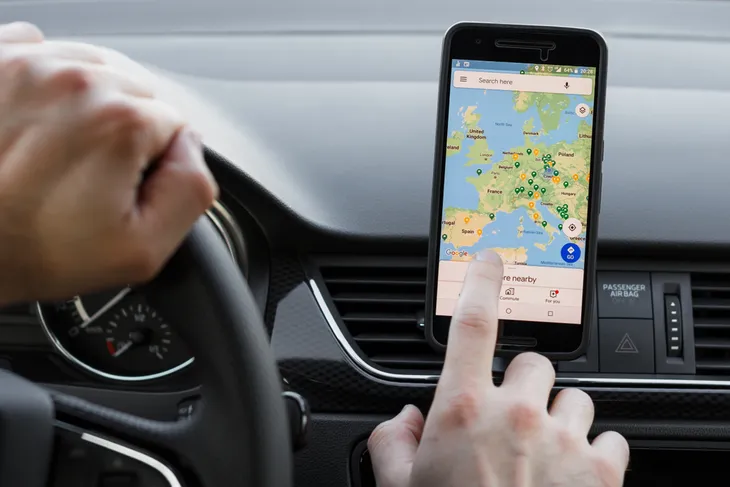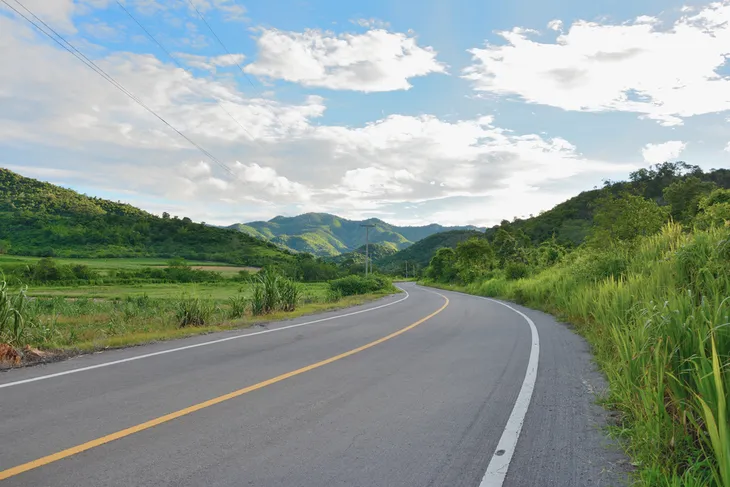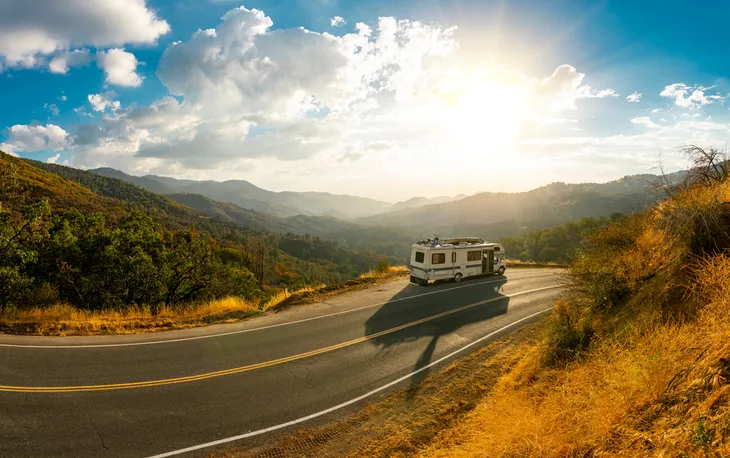- A well-planned road trip gives you the opportunity to experience travel in a more enriching and adventurous way.
- There are many different ways to road trip, from staying in high-end hotels to free camping in the remote outdoors.
- The unexpected journeys and moments of road trips are the most rewarding and memorable experiences.
Road trips are one of the most memorable ways to vacation. Regardless of whether you’re driving for days, weeks or even months, you have the opportunity to explore your destinations with extra freedom and flexibility. While the destinations are a highlight of the trip, road trips also encourage you to truly enjoy the journey, leaving you with memories and experiences that you’ll look back on for the rest of your life.
While road trips are intended to be flexible and spontaneous, you’ll obviously want to avoid any major issues that could completely derail your trip. To help you plan your road trip and get the most out of your adventure, we’ve created this guide.
Identify Key Destinations and Dates
The first step to planning your road trip is seemingly simple, but knowing where you want to go can sometimes be a struggle once you’re already on the road. Create a list of the places you want to visit within the same trip using inspiration from social media, travel blogs, guidebooks and other sources. Identify which destinations are a priority, then assign them an arrival date. This will create a loose schedule and visual representation of your overall destination plan, allowing you to see if there’s more or less time for other destination options.
Once you know where you want to go, you can also start researching accommodations, activities and attractions available. Knowing which key destinations you’ll be visiting also helps inform what you should pack, what kind of vehicle to take (or rent) and other easily forgotten details.
 Shutterstock/Soloviova Liudmyla
Shutterstock/Soloviova LiudmylaPlan Your Route
With your key destinations and dates in mind, start planning your route. Save each destination in a Google Maps list so you can refer to and plot them as many times as necessary. You can even add notes to lists and saved locations or customize labels to differentiate between location categories like parks, cities and accommodations. Don’t forget to download offline maps in case you can’t access cell service.
Google Maps allows you to input multiple destinations in your preferred order, giving you an entire route overview with driving times and distances. With your route in mind, consider how long you’ll be driving for each day and where you can take rest stops or check out off-the-beaten-path attractions. Keep these logistics in mind when planning your route, making adjustments as necessary:
- How many total miles are you traveling?
- How much time do you have?
- How far are you comfortable driving in a day?
- Are there days you won’t be driving at all?
- Do you have alternative routes or destinations in case of delay?
 Shutterstock/Vladimka production
Shutterstock/Vladimka productionEstablish a Budget
Setting a budget is an important part of determining which activities and places you’ll visit. Get an idea of how much you’re willing to spend on necessities like fuel, food and accommodations, as well as how much you want to spend on the fun electives.
Planning your budget keeps you accountable but also lets you breathe easy, knowing you have a certain amount of money to spend how you like. Consider possible unexpected expenses, like vehicle repairs or tow trucks. Save costs by traveling with others, avoiding peak season and cooking for yourself rather than eating out for every meal.
 Shutterstock/ADragan
Shutterstock/ADraganOrganize Accommodations
The types of accommodations you choose can vastly change your road trip experience. You can stay in ritzy hotels, in cozy Airbnbs or even in your vehicle. Staying in hotels means you’ll need to arrive in a city each day, while camping or van-lifing means you’ll have to look up spots to stay out of cities. Some campsites can be expensive during peak seasons, but some parks and other land, particularly BLM land, allow campers to stay for free. It’s important to know your options to suit your ideal trip. Consider other amenities you may want, such as:
- Toilets
- Showers
- Laundry
- Cooking
- AC/Heat
- Parking
- Pet-friendly
 Shutterstock/Africa Studio
Shutterstock/Africa StudioGet Your Vehicle Road Trip Ready
Before you leave for a long trip, ensure your vehicle is safe and prepared for the miles you’re going to put on it. That means performing any needed maintenance and keeping a safety kit in your vehicle. If you’re traveling in adverse weather conditions, make sure you have suitable tires and drivetrain capability. You may opt to rent a vehicle if it fits your road trip needs better in terms of drive capabilities, fuel efficiency or livability if you’re planning on sleeping in it.
You’ll also want to be sure to pick up the right aux and charging cables so you can play music and keep your devices charged.
 Shutterstock/Tanasan Sungkaew
Shutterstock/Tanasan SungkaewPrep Snacks and Meals
While you’ll want to indulge in local cuisine, you’ll also need snacks and meals for long stretches of driving. Bring a mix of healthy snacks and treats to keep cravings and hunger at bay. Fill a cooler with vegetables, fruits, cheese and crackers, drinks and so on, making sure to have good protein, carb and fat sources on hand. Keep extra water handy too.
For meals, you’ll need to know what your budget is for the trip. This will inform how many of your meals you can afford to eat out for and what types of restaurants you should be considering. If you’re going to be cooking for yourself a lot, get travel-sized containers for salts, oils and any other basics so you don’t have to buy full-sized portions during your trip. This saves space in your vehicle and overall grocery costs.
 Shutterstock/Dmytrenko Vlad
Shutterstock/Dmytrenko VladEntertainment on the Road
Long periods of driving can be dull, but having the right entertainment can help. Create a playlist with your road trip buddies or download your favorite podcasts beforehand. You could also listen to an audiobook, which can help pass the time quite quickly if you’re invested in the storyline. Bring back car games from childhood, and keep books or puzzles on hand for when you get a break from driving.
If you’re bringing children on your trip, ensure to bring some entertainment to suit their needs as well. If you have a tablet, you could stock it with a few of their favorite shows, or bring some small games or books.
 Shutterstock/antoniodiaz
Shutterstock/antoniodiazHygiene and Health Essentials
Even being on the road for a few days can leave you feeling a little sweaty and smelly. Bring a kit of travel-sized hygiene essentials like shampoo, face wash, toothpaste and a toothbrush. Baby wipes are also particularly useful when you need to freshen up but don’t have access to showers.
Keep a first-aid kit on hand, and make sure to top up supplies if you already have one. Organize medication prescriptions if you have any, and consider bringing other essentials like ibuprofen and nausea remedies. Don’t forget sunscreen either!
 Shutterstock/Alex Cimbal
Shutterstock/Alex CimbalConsider Eco-Friendly Options
One of the major downsides of road trips is that even fuel-efficient vehicles will use a lot of gas during long drives. Try to optimize your fuel efficiency by keeping your vehicle’s maintenance current or even renting a more fuel-efficient vehicle than you currently own. You can also offset your extra carbon footprint by donating to environmental initiatives.
Another good tip is that when you’re on the road, try to avoid extra packaging or waste. Bring reusable items like water bottles and cutlery. If you do have waste, keep it with you until you find a suitable spot to dispose of it.
 Shutterstock/Igisheva Maria
Shutterstock/Igisheva MariaCreate a Checklist
Obviously we’ve given you a lot of information and items to bring on your trip, and it’s easy to forget or neglect certain things. To keep yourself organized, create a checklist of all the items and information you need for your trip. You could even categorize this list into smaller groups to ensure you have everything you could possibly need.
Writing down everything you need and checking them off as you go will ensure nothing is forgotten and make the lead up to your trip as easy as possible. Double-check and even triple-check, but don’t stress if you forget a few non-vital things.
 Shutterstock/sutadimages
Shutterstock/sutadimagesAvoid These Common Mistakes
Even with the most thorough road trip guide, it’s easy to make some mistakes. Many road trippers start ambitiously but end up derailed by avoidable errors. Don’t feel bad if you make any of these mistakes though, since they’re quite common! To avoid them, however, you can easily do some research to ensure you’re as prepared as possible. Consider these common mistakes:
- Underestimating travel times and not allowing for a buffer
- Not planning for enough recovery time from driving
- Sticking too rigidly to itineraries
- Not considering weather or seasons
- Failing to communicate needs and boundaries with travel partners
- Forgetting to fuel up before long driving stretches
 Shutterstock/Tawan teerak
Shutterstock/Tawan teerakEnjoy Hiccups and Spontaneity
Meticulous planning can certainly help make your road trip memorable, but the best experiences often come unplanned. This guide is intended to help you prepare as much as possible for your road trip, but you should ultimately be ready to embrace the inevitable hiccups. Changing schedules or destinations might lead you to something amazing you’d have otherwise missed out on. The journey itself is what makes a road trip the experience of a lifetime, so be ready to capitalize on spontaneous moments and opportunities as they come your way!
 Shutterstock/LeStudio
Shutterstock/LeStudio

